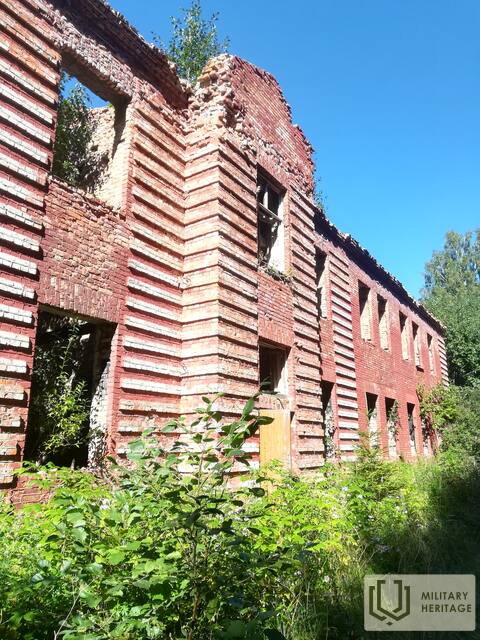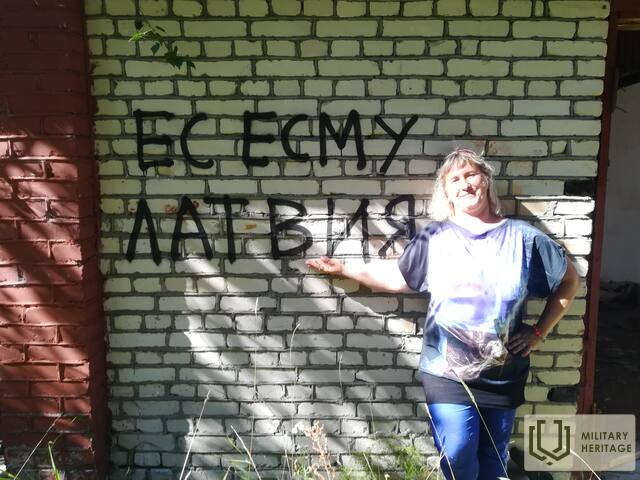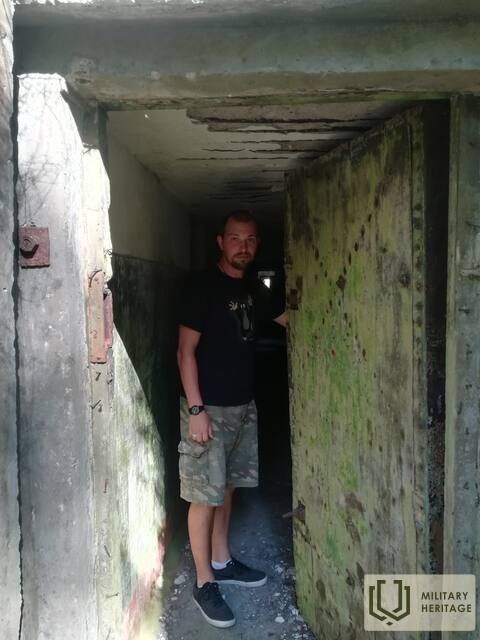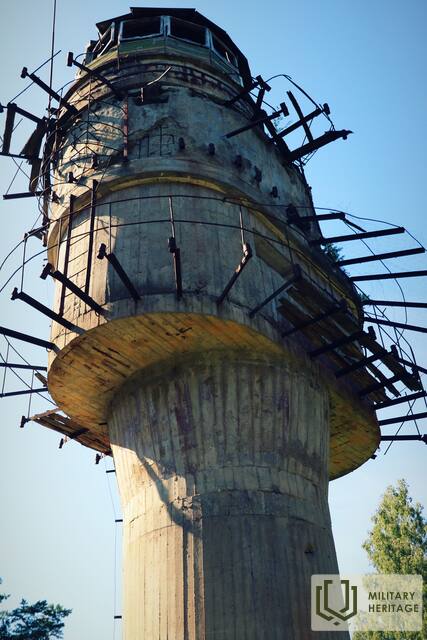Krasnoflotsko likimas po sovietų pasitraukimo
Po to, kai 1993 m. paskutiniai sovietų kariai paliko Latviją, Krasnoflotsko arba Olmanio pakrantės gynybos baterija taip pat atiteko Latvijos nacionalinėms gynybos pajėgoms. Netrukus šį našlaičių turtą pradėjo konfiskuoti pelno siekiantys žvalgytojai.
1993 m. kariai pasitraukė iš Olmanio, pasiimdami raketas ir sviedinius. Visa kita – pastatai, įranga ir kiti daiktai – buvo perduoti Latvijos vyriausybei. Kurį laiką Latvijos kariuomenės miestelį saugojo Latvijos vidaus gvardija. Latvijos NBS svarstė galimybę pasilikti pakrantės gynybos bateriją, kad ateityje ją būtų galima naudoti tiek mokymams, tiek gynybai. Tokios pakrantės gynybos baterijos egzistavimas suteiktų Latvijai karinę Irbenės sąsiaurio kontrolę ir užtikrintų tvirtą gynybą politinės eskalacijos atveju. Tārgalės parapijos taryba taip pat primygtinai reikalavo išsaugoti šią vietą turizmui. Tuometinis parapijos tarybos vykdomasis direktorius Ivaras Smukkalnas ne kartą kreipėsi į regionines ir nacionalines valdžios institucijas, prašydamas patikėti šios vietos valdymą vietos savivaldybei. Visa Europa būtų atvykusi pamatyti unikalios pakrantės gynybos baterijos, kaip dabar europiečiai atvyksta pamatyti Sveaborgo tvirtovės, kurioje taip pat yra rusiškų patrankų ir kuriai suteiktas UNESCO pasaulio paveldo statusas.
Deja, dėl pinigų trūkumo nė vienas planas nebuvo įgyvendintas, o pakrantės baterija liko likimo valiai, o kariuomenės miesteliu ir patrankomis kurį laiką rūpinosi kultūros ir istorijos entuziastai Edgaras ir Zoja Sīļi. Tačiau 200 tonų pirmos rūšies metalo vagims ir vandalams taip ir nepavyko. Miesto turtą ir turtą išgrobstė plėšikai, kurie taip pat nusiaubė pasienio apsaugos postą prie Irbės upės. Pačioms patrankoms pavyko išlikti savo vietose dar trejus metus, tačiau 1996 m. jos taip pat buvo sunaikintos. Po juodojo metalo vagių atėjo kabelių vagys, buvo išardyti galingi dyzeliniai generatoriai, pakeistas atstumo matuoklis, o kariniai ekspertai pavogė formuliarus ir brėžinius. 2006 m. du asmenys, apsvaigę nuo alkoholio, padegė kareivines neatsargiai elgdamiesi su ugnimi. Abu žuvo gaisre. Iš kareivinių liko tik plytų sienos. Unikalus karo istorijos palikimas buvo sunaikintas ir apleistas. Dabar į jį užsuka tik retas karo istorijos entuziastas.
Olmaņi. Baterija Nr. 456 (diggers.lv)
Susijusi laiko juosta
Susijusios temos
Susijusios vietos
Olmano baterija Nr. 456 (sovietų karinė bazė „Krasnoflotska“)
Pirmosios pakrantės gynybos baterijos Irbės sąsiaurio gynybai buvo pastatytos po 1912 m., kai buvo patvirtintas Baltijos laivyno minų ir artilerijos gynybos pozicijų planas, kuriame buvo numatytos kelios pakrantės gynybos baterijos ir jūros minų statymas.
Irbės sąsiaurio pozicija buvo toliausiai į pietus, o jos užduotis buvo užblokuoti bet kokį priešo patekimą į Rygos įlanką. Pagrindinis dėmesys buvo skiriamas jūrinėms minoms, kurių dešimtys tūkstančių buvo padėti Irbės sąsiauryje Pirmojo pasaulinio karo metu Baltijos laivyno laivai. Tik 1916 m. Saremos salos pietiniame gale, Sorvės kyšulyje, pradėtos statyti pakrantės gynybos baterijos. Iš viso buvo pastatytos septynios baterijos, o 43-ioji baterija buvo aprūpinta 305 mm pabūklais. Latvijos Irbės sąsiaurio pakrantėje gynybos baterijų nebuvo pastatyta.
Net ir įkūrus Latvijos Respubliką, Latvijos armija ir karinis jūrų laivynas neįrengė artilerijos pozicijų Irbės sąsiauriui ginti.
Padėtis pasikeitė po 1939 m. spalio 5 d. Latvijos Respublikos ir SSRS savitarpio pagalbos pakto, kuris numatė Raudonosios armijos ir Baltijos karinio jūrų laivyno kontingento dislokavimą Kuržemėje. Sovietų Sąjungos planuose taip pat buvo numatyta sukurti pakrantės gynybos sistemą pagal 1912 m. planą su patobulinimais. Buvo numatyta pastatyti pakrantės gynybos baterijas Liepojos tvirtovės vietoje, naujas baterijas į pietus nuo Ventspilio (46-oji baterija) ir dvi baterijas siauriausioje Irbės sąsiaurio dalyje netoli Mikeltornio. Jau po Latvijos okupacijos ir aneksijos Baltijos karinio jūrų laivyno pakrantės gynybos planai buvo papildyti ir iki 1941 m. birželio mėn. buvo planuojama įkurti 207-ąją artilerijos diviziją su penkiomis baterijomis šiaurinėje Kuržemės dalyje. Mikeltornio apylinkėse turėjo būti įrengtos dvi baterijos – 40-oji baterija Lūžnoje su 130 mm B-13 pabūklais gelžbetoniniuose įtvirtinimuose ir 117-oji baterija Olmaniuose (vieta Latvijos armijos žemėlapiuose pažymėta Ķesteriais) su 152 mm MU-2 pabūklais. Kadangi 152 mm pabūklų kūrimas nebuvo baigtas, ant baterijos gelžbetoninių įtvirtinimų buvo pastatytos laikinos medinės platformos ir sumontuoti dar keturi 130 mm pabūklai. Abi baterijos buvo baigtos iki 1941 m. birželio mėn., tačiau kare prieš vokiečių 291-ąją pėstininkų diviziją baterijų nepavyko aptikti, todėl jų įgulos persikėlė į Saremos salą.
Antrojo pasaulinio karo pabaigoje Vokietijos armijų grupė „Kuršas“ gana rimtai svarstė galimus sovietų išsilaipinimus šiaurinėje Kuršo dalyje, ypač ištirpus ledui Suomijos įlankoje ir vakarinėje Estijos pakrantėje. Visoje Kuršo pakrantėje buvo dislokuotos savadarbės pakrantės gynybos baterijos. Sovietų Sąjungos 40-oji baterija „Gerate Batterie Sommer“, priklausanti 289-ajai artilerijos divizijai, su dviem 122 mm sovietinėmis haubicomis, buvo dislokuota gelžbetoninėse pozicijose netoli Lužnės. 117-osios baterijos pozicijų rajone buvo 530-osios artilerijos divizijos 2-oji baterija su trimis 152 mm sovietinėmis trofėjinėmis patrankomis, trimis 37 mm zenitiniais dronais, vienu 20 mm keturių vamzdžių zenitiniu dronu, dviem 75 mm prieštankinėmis patrankomis ir dviem minosvaidžiais apšvietimui.
Pasibaigus aktyviems karo veiksmams 1945 m. gegužę, SSRS pradėjo atkurti pakrantės gynybos sistemą Kuržemės pakrantėje. 1945 m. rudenį netoli Olmanių ūkio, kuris buvo pervadintas į „Krasnoflotskaja“, buvo dislokuota laikina 456-oji baterija su 152 mm Kane sistemos pabūklais.
1952 m. laikini baterijos pabūklai buvo pakeisti naujausiais 152 mm MU-2 ginklų sistemomis. Bateriją sudarė keturios gelžbetoninės pabūklų pozicijos, gelžbetoninis vadovavimo postas su tolimačio bokšteliu ir techniniai pastatai. Baterijos statyba buvo baigta 1958 m.
1958 m., išmontavus Lūžnios pakrantės gynybos bateriją, ją pakeitė mobili 130 mm SM-4-1 patrankų baterija Nr. 343. Mobiliosios patrankos neturėjo gelžbetoninių patrankų lizdų, tačiau buvo pastatytos kelios rąstų ir smėlio konstrukcijos.
343 baterija veikė iki septintojo dešimtmečio pradžios, o 456 baterija – iki 1975 m., kai buvo išsaugota. Baterijų pozicijose buvo dislokuoti S-125 oro gynybos raketų kompleksai, taip pat 10-asis pakrantės gynybos artilerijos-raketų pulkas su CP-2 „Sopka“ raketų kompleksais, o infrastruktūra buvo atitinkamai modifikuota.
Sovietų armija Olmanių ir Lūžnių baterijų infrastruktūrą Latvijos Respublikai perdavė 1993 m.










